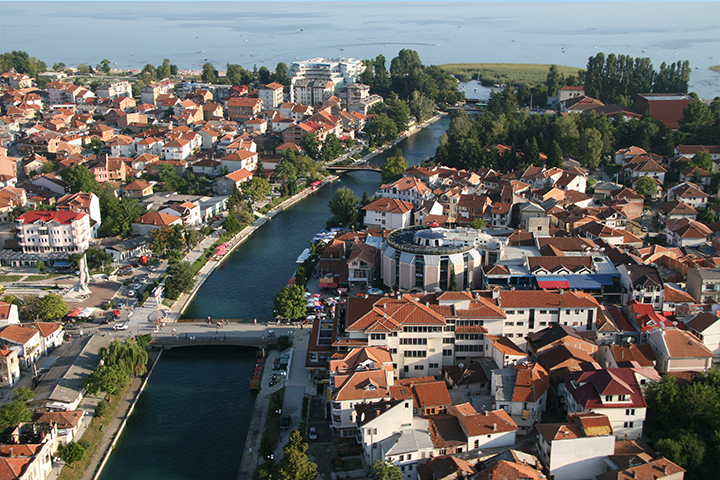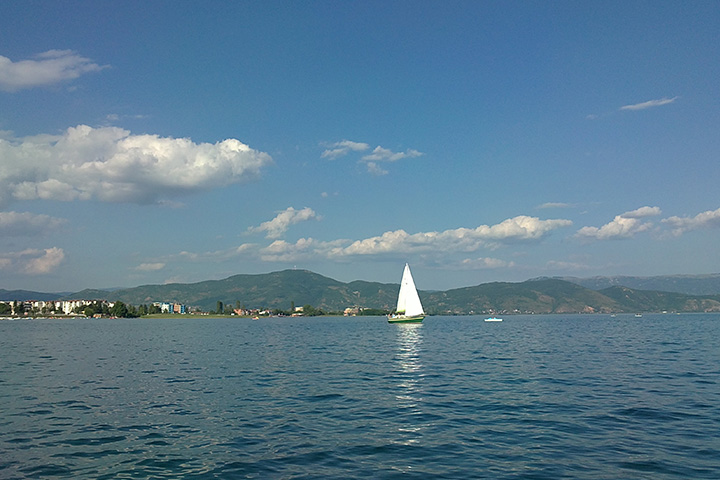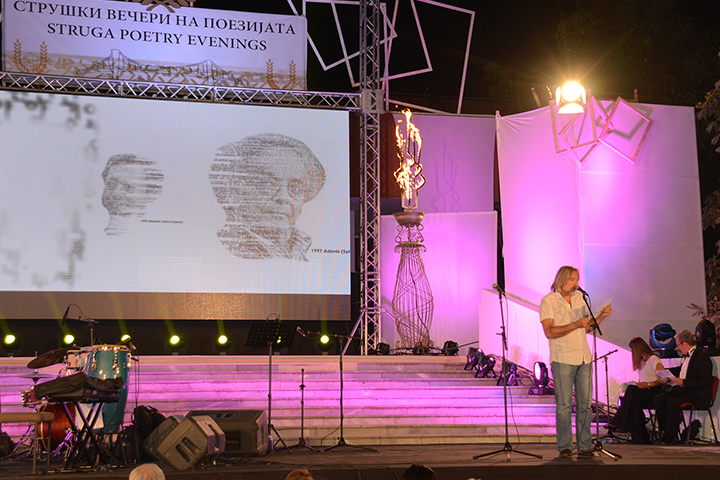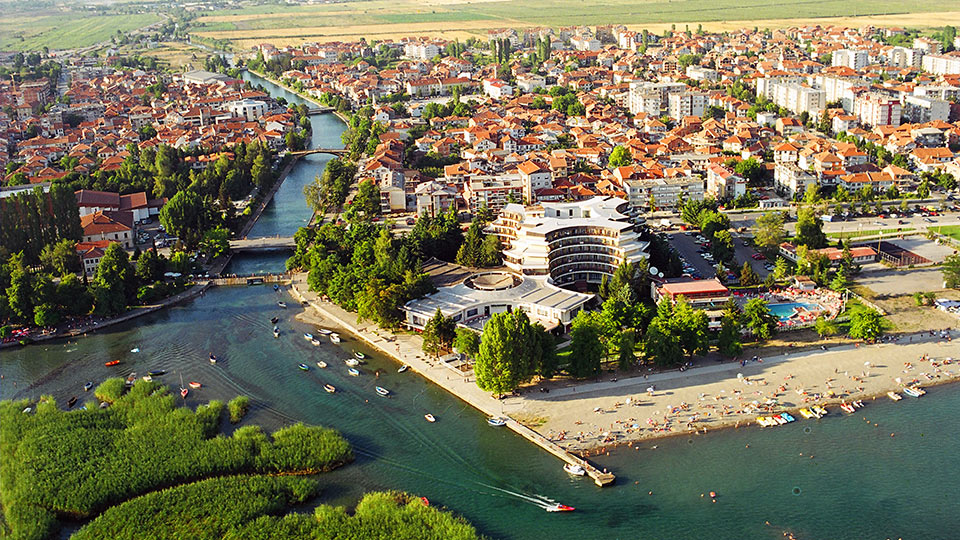Struga
The main characteristics of the tourism in the Municipality of Struga are: relatively favorable geographic positioning and relatively developed road infrastructure, mild continental climate with high level of sun insolation during the whole year, extraordinary fund of endemic species of flora and fauna, protected and preserved natural habitat, rich cultural and historic heritage with a considerable number of monuments and archeological sites, mountain ranges favorable for winter tourism, traditional welcome and folklore, healthy and traditional food consuming, unique cultural manifestations, Struga is situated in the southwestern part of the Republic of Macedonia, on the shorelines of the Lake Ohrid and alongside the banks of the River Black Drim that divides the city into two.


Struga is well linked and easily accessible with the neighboring regions: only 14 km away from the border with the Republic of Albania, 160 km with the Republic of Kosova (from Tetovo) or 190 km in the North (from Skopje), 100 km from the Republic of Greece, 290 km from the Republic of Bulgaria and 230 from the border with the Republic of Serbia. The International Airport only 9 km away connects Struga with the rest part of the world.
Struga has a surface of 573 km2and lies at 698 meters above sea level; there are 63376 inhabitants, 130 inhabitants/ km2, in 50 settlements. Maximum average temperatures reach 27 degrees centigrade in July and August, but in the warmest days of the summer they reach out to 35-40 degrees centigrade. Average temperature of the water of the lake Ohrid in summer is 26 degrees centigrade, while the temperature throughout the year reaches up to around 12 degrees centigrade. In the winter, average temperature is above 0 degrees centigrade, making thus a comfortable and pleasant environment to be accommodated and stay in this time of the season. The average days with relatively high temperatures reach to 80 days in the year, accompanied by intensively high temperatures in July and August. The insolation in Struga is very high, with 2,200 hours of insolation, Struga is one of brightest places in the Republic of Macedonia.
NATURAL RICHIES OF STRUGA
The Lake of Ohrid lies at an altitude of 695 meters above sea level and occupies an area of 348,2 km², from which 230 km² are on the side of the Republic of Macedonia and the rest of 118,2 km² belong to the Republic of Albania. The cost line of the lake is 87,5 km long. The average depth of the lake is 164 meters and the maximum depth of the lake is 289 meters, with a high transparency that reaches up to 24 meters. The Lake is characterized with a very unique ecosystem consisted of a rich world of flora and fauna that is very rare. The biodiversity of the lake and the trails of very old settlements and prehistoric civilizations that have existed here made possible for Lake Ohrid to be listed and constantly protected by the UNESCO as a cultural heritage of planetary proportions.
The River Black Drim is the only exit of the lake’s water. As it flows in the north, the river creates the two artificial lakes: Lake Globochitza and Lake Shpile. The eels found in the Lake Ohrid, through the river, pass seas and oceans on their “honeymoon” to arrive to the Sargasso Sea, where they meet their partners and breed.


The Yablanitsa Mountain is one the most important mountain ranges in Macedonia because of the rich flora and fauna. On the slopes of this mountain lie panoramic villages. Today, there are some initiatives to declare the mountain range as a national park. Glacial lakes on the Yablanitsa Mountain are situated more than 2000 meters above sea level with breathtaking views of Struga and the Lake Ohrid. Artificial lake of Shum in situated in the village of Shum only 6 km away from the city of Struga. The uniqueness of this lake is the breeding of the Lake Ohrid trout.
Flora in the region of Struga is characterized with a unique and endemic living world that cannot be found in any other places in the world (lake reeds, oak hills and forests, beech, chestnuts, curative flora, ornamental flora and different mountain mushroom species). Fauna also is characterized with endemic forms of life and endangered species like mountain bears, wolves, dears, wild lynx, goats and lake swans, ducks and gooses.
The admirers of nature have the opportunity to visit the tourist villages of Vishni, Upper Belitza, Labunishta and Podgortsi to feel the breathtaking views of the Lake Ohrid in over 2000 meters above sea level, the glacial lakes, mountain springs and meadows during the winter season fulfilled with snow, in spring with flowers, in summer with green colors and in gilded autumns. The admirers of the deep blue color of Lake Ohrid can relax in the fishermen villages of Kalishta and Radozhda.
CULTURAL AND HISTORIC RICHIES OF STRUGA
As a result of the natural conditions and the strategic geo-politic position between West and East, Struga and its surroundings have been continuously populated and featured a cradle of ancient civilization. Archeological findings bear witness that near the mouth of the river Black Drim was established the ancient city of Enchalon.
The “Via Egnatia” penetrated in the region of Struga, more precisely, passed through the village of Radozhda, Struga. Inside the church of St. George in Struga was found a millennium stone “Egnatia” on which is written the name of the Roman emperor Karakalus (211-217 B.C.) and the distance of 12 km dividing Struga from Ohrid.
The most known temples of the Christian religion are: the church of St. George of the city of Struga, the church complex near Kalishta, from the XV century, the church of St. Spas inside a cave in the village of Vishni, from the XV century, the church of St. Archangel Michael in Radozhda, from the XI century.
The most representative temples of the Islamic religion in Struga are the mosques and a teke: the Mosque of Suleiman Arap built in 1583, near the river Black Drim, the Mosque of Mustafa Celebi near the city centre, built in the late XV century, the Teke of Helveti, built by Baba Hasan in the XVIII century and the Hamam of Mustafa as a representative of the rarest Turkish monuments built in the years when the Ottomans came to Struga.
The Natural Scientific Museum “Dr. Nikolla Nezllobinski” in Struga is one of the oldest institutions in Macedonia and represents a complex institution consisted of several departments as: the Biological Department, Preparatory Lab, Department of Archeology and Figurative Art and the Department of History and Ethnology. In the Museum there is an exhibition of 9,381 specimens of flora and fauna founded in the shores of the Lake Ohrid, about 2,576 items that originate from pre-history, the ancientness, medieval era and items from the contemporary period.


A very important part of the Museum is the art gallery “Vangel Kodzoman” consisted of 35 paintings, a true collection of this artist from Struga. His paintings reflect the dynamic of the living and life in Struga, together with motives from the old city architecture.
The city architecture of the XIX century and the beginning of the XX century in Struga can be noticed from the old houses. The accent should be put to the fact that most of the houses and other buildings of this period are characterized with an architectural harmony and functional emplacement of the interior and exterior elements.
The Festival of refined and styled folk songs and dances “Këngë jeho” takes place in Struga every year in the end of July and in the beginning of August. The festival, established in 1992, for many years has revealed the true cultural and artistic values of the ethnic Albanian soul and the colors of the traditional costumes and dances. The festival presents the traditional values of the cultural artistic associations from Macedonia, Albania, and Kosovo and all over the world.
The “Struga Poetry Evenings”
The “Struga Poetry Evenings” as an international event began in 1966. As a result, the international poetry award “The Golden Wreath” was established, and is awarded to the best poet. For the years passed away, Struga has welcomed and hosted over 4,000 poets, essayists, and well-known critics from 95 different countries all over the world.
“The Review of Folk Costumes” is one of the most important cultural and touristic manifestations that traditionally takes place in Struga in the beginning of August, since 1971. This cultural event aims at presenting the cultural wealth of folk costumes and embroidery from the tradition coming from the tradition of all ethnic communities living in the Struga region. The parade of the participants in the streets of Struga and along the river Black Drim is a special moment and an extraordinary happening for the visitors.
The citizens of Struga can be very proud of the many and old crafts. According to this, we can point out the manufacturers of silver jewelry, hand-made filigree, old-style loom weaving, decorative wood-carving, pottery and many other handicraft shops that are located mainly in the old city bazaar.
The traditional cuisine cherished for centuries in Struga invites you to taste the deliciously prepared eel and trout a lá Struga, fli or dzomleze (national pie) under hot iron pan, pie and beans cooked in earthen pan, baklava and other sweeties.
The accommodation capacities in the Municipality of Struga are: 25 hotels with 4500 rooms and approximately 6000 beds, 10 motels with a capacity of 100 rooms with 250 beds and 200 private guest houses and apartments with 2000 rooms or 4000 beds. Thus, in Struga can be accommodated almost 10.000 tourists a day. In the Municipality of Struga there are 60 restaurants with a traditional and modern cuisine, 50 fast-food and 60 cafés for everybody’s preferences as well as 20 travel agencies that organize the trips for the tourists.

Click here to see Accomodation in Struga

